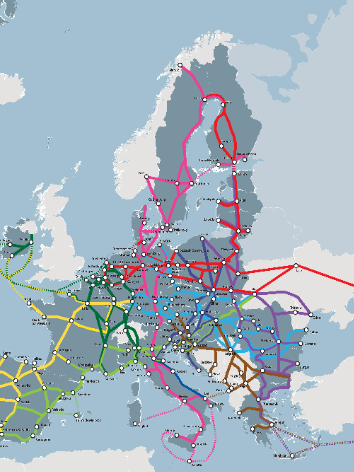Urban mobility planning: Global Gateway in African cities and experiences from the European TEN-T

Picture by the Directorate-General for Mobility and Transport, European Commission - Extracted from File: Trans-European Transport Network (2024)
The Global Gateway is the European Union's strategic initiative aimed at enhancing global connectivity by investing in infrastructure, digital solutions, climate resilience, energy, transport, health, and education projects. Its primary focus is on sustainable development and creating strong, equitable partnerships across the world. In particular, the strategy has a key emphasis on the African continent, where it proposes eleven "strategic corridors" to enhance secure, efficient, and sustainable transport networks.
The strategic corridors proposed by the Global Gateway are designed to facilitate movement of goods and people, which will boost economic growth by supporting value chains, services, and job creation in Africa and Europe. These corridors are crucial for industries, as they help connect key infrastructure and promote smoother, more efficient trade routes.
These corridors mirror the approach of the Trans-European Transport Network (TEN-T) policy within the EU. The TEN-T aims to create a transport network across Europe, linking major cities, ports, and infrastructure through roads, railways, air, and waterways. Additionally, it promotes sustainable and low-carbon transport options, aligning with environmental goals.
Within the TEN-T framework, nine core network corridors have been established, covering 431 cities identified as "urban nodes." These nodes are vital hubs within the network and must adopt a Sustainable Urban Mobility Plan (SUMP) by 2027. The SUMP mandates the collection and submission of data on urban mobility indicators, serving as a tool to manage and enhance local mobility.
An urban node is characterized by multi-level or multi-actor governance structures, often encompassing multiple urban areas managed by different entities. These nodes play a dual role:
- Mass Transit Hubs: Providing public transport for commuters, ensuring seamless travel for residents.
- Interconnection Points: Facilitating the integration of different transport modes within the TEN-T network.
By developing SUMPs, cities within the TEN-T can gather baseline data on mobility patterns, identify key stakeholders, and propose actionable steps that align with TEN-T's broader goals of sustainability and connectivity.
Africa is home to some of the fastest-growing cities, presenting challenges and opportunities for transport systems. The Global Gateway recognizes the potential to scale up mass transit systems in these cities. A key aspect of this approach involves strategically reorganizing the existing small-scale public transport networks to create more efficient, large-scale systems.
For mass transit to function effectively and sustainably, several conditions must be met:
- Governance schemes: Context-specific governance schemes are required to ensure public transport operation and coordination, including paratransit.
- Effective integration: Cities need to regulate and integrate public transport, including paratransit systems, ensuring that fare structures are equitable, and transit routes are well connected.
- Affordable and efficient system: Public transport must remain affordable, especially for low-income users, while improving safety and operational standards. To ensure the efficiency of the system, interoperable payment systems across different modes should be considered.
Strategic urban mobility planning, particularly along regional corridors, will be essential for Africa’s future transport connectivity. Considering the "urban corridor" dimension means developing networks that harmonize local mobility needs with broader national and regional goals.
Sustainability is central to the Global Gateway's transport objectives for Africa. The initiative seeks to reduce the environmental and climate impacts of transport through various measures, including:
- Reducing vehicle activity: Aligning transport planning with land-use planning in urban areas can shorten commuting distances and reduce overall travel demand.
- Lowering energy intensity and fuel carbon content: Financial and regulatory incentives can encourage fleet renewal, promoting the use of more energy-efficient vehicles.
- Promoting modal shifts: This includes shifting from cars to mass transit and non-motorized transport in urban areas.
- Transitioning to electric and CNG vehicles: Public transport fleets, should transition towards electric or compressed natural gas (CNG) vehicles to reduce emissions and contribute to greener urban environments.
The Global Gateway’s focus on building sustainable, strategic corridors in Africa represents a significant step toward improving connectivity between the two continents. By learning from the TEN-T and integrating mass transit reforms with sustainability initiatives, the EU aims to promote a transport network that not only enhances economic ties but also prioritizes environmental responsibility. This partnership-driven approach seeks to create long-term benefits for both regions by fostering growth, innovation, and climate resilience in their transport systems.